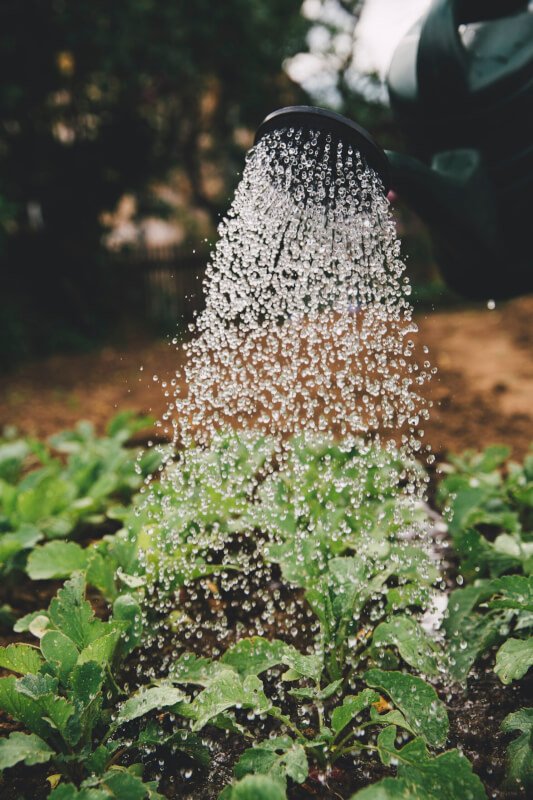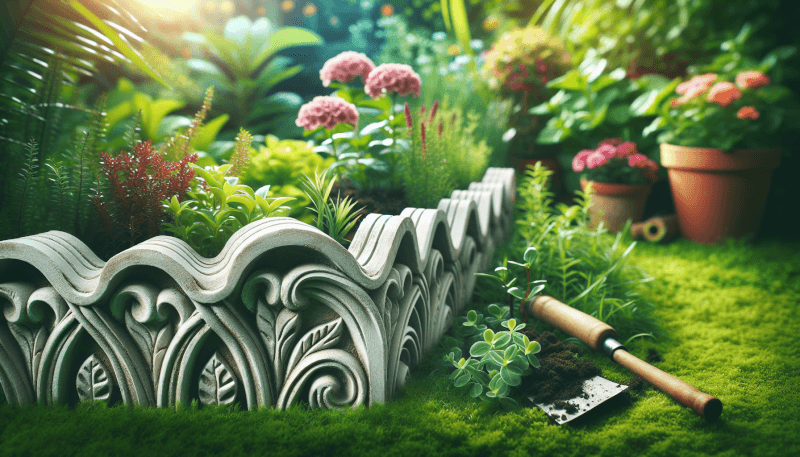Are you looking to give your garden a polished and professional look? Look no further! In this article, we will share a variety of DIY garden edging ideas that will transform your outdoor space into a beautiful and well-defined oasis. From using bricks and stones to recycled materials and plants, these ideas are not only budget-friendly but also easy to implement. So whether you have a small backyard or a large garden, get ready to discover the perfect garden edging ideas that will add that finishing touch to your outdoor sanctuary.

Creative Materials for Garden Edging
Pallet Wood
One of the most popular and cost-effective materials for garden edging is pallet wood. With a little creativity and some basic woodworking skills, you can transform wooden pallets into charming and rustic garden borders. Simply dismantle the pallets and cut the pieces to your desired length. You can then arrange them in a straight line or create interesting patterns by placing them diagonally or vertically. The weathered look of pallet wood adds character to your garden and complements a variety of plants and flowers.
Wine Bottles
If you’re a wine lover, why not repurpose your empty wine bottles as garden edging? This unique and creative idea adds a touch of elegance to your garden while also being environmentally friendly. To create wine bottle garden edging, start by digging a shallow trench along the border of your garden. Carefully bury the wine bottles upside down in the trench, leaving just the neck of the bottle exposed. You can use bottles of different colors to create a stunning visual effect. This DIY project not only adds visual interest to your garden, but it also helps to recycle and reduce waste.
Concrete Blocks
Another versatile and affordable option for garden edging is concrete blocks. These blocks are durable, long-lasting, and can be arranged in various ways to suit your garden’s style. Stack them horizontally or vertically to create a border that is as simple or intricate as you desire. You can even paint the concrete blocks to match your garden’s color scheme or leave them as they are for a more natural look. Concrete block garden edging is not only visually appealing but also provides a sturdy barrier to keep your plants contained and protect them from encroaching grass or weeds.
Terracotta Pots
If you want to add a touch of charm and elegance to your garden edging, consider using terracotta pots. These timeless and classic pots can be repurposed to create a unique and eye-catching border for your garden beds. To create terracotta pot garden edging, start by burying the pots partially in the soil along the perimeter of your garden. You can use pots of different sizes and arrange them in a straight line or in a staggered pattern for a more organic look. The natural reddish-brown color of the terracotta pots adds warmth and beauty to your garden, while also providing a practical and functional border.
Railroad Sleepers
For a more rustic and industrial look, consider using railroad sleepers as garden edging. These heavy-duty wooden beams were once used to support railroad tracks but have now become a popular material for landscaping projects. Railroad sleeper garden edging adds a touch of nostalgia and creates a distinct border for your garden. Simply dig a trench along the edge of your garden and place the railroad sleepers vertically or horizontally. The weathered and worn appearance of the sleepers adds character and interest to your garden, making it a unique focal point in your outdoor space.
Natural and Organic Garden Edging
Stone Borders
If you prefer a natural and organic look for your garden edging, stone borders are an excellent choice. Stones come in a variety of shapes, sizes, and colors, allowing you to create a border that suits your garden’s style. Whether you choose large boulders, smooth river rocks, or flat flagstones, stone borders add an earthy and timeless appeal to your garden. Simply dig a shallow trench, place the stones along the edge, and backfill with soil to secure them in place. Stone garden edging not only adds visual interest but also provides a natural barrier between your garden and the surrounding landscape.
Bamboo Edging
For a touch of exotic flair, consider using bamboo as garden edging. Bamboo is a fast-growing and sustainable material that adds a unique and tropical vibe to your garden. Simply install bamboo poles vertically along the edge of your garden, using a strong adhesive or tie them together with natural twine. You can also create a more intricate design by weaving bamboo stalks horizontally or diagonally. Bamboo garden edging is not only visually appealing but also provides a natural barrier and privacy screen for your garden.
Tree Branches
For a truly natural and rustic garden edging, look no further than tree branches. Fallen or pruned branches can be repurposed to create a charming and organic border for your garden beds. Simply trim the branches to your desired length and arrange them along the edge of your garden. You can use branches of different sizes and shapes to create a whimsical and artistic effect. Tree branch garden edging blends seamlessly with the surrounding landscape and adds a touch of nature to your outdoor space.
Living Edges
If you want your garden edging to be more than just a physical border, consider using living edges. Living edges utilize plants and vegetation to create a soft and natural transition between your garden and the surrounding areas. Choose low-growing plants or groundcovers with a spreading habit and plant them along the edge of your garden beds. As they grow and spread, these plants will create a lush and seamless border. Living edges not only provide a beautiful and textured frame for your garden but also attract beneficial insects and wildlife.
Flower Bed Border with Rocks
One of the simplest and most effective ways to create garden edging is by using rocks. Rocks are readily available, durable, and can be arranged in various patterns to suit your garden’s style. For a flower bed border with rocks, start by digging a shallow trench along the edge of your garden. Then, place the rocks of your choice in the trench, ensuring they are securely embedded in the soil. You can use rocks of different sizes and colors to create a visually stunning border that complements your garden’s color palette. This DIY garden edging idea adds a natural and timeless appeal to your outdoor space.
Recycled and Upcycled Garden Edging
Old Bicycle Wheels
If you have some old bicycle wheels lying around, why not repurpose them as unique garden edging? This creative and whimsical idea adds a touch of nostalgia and brings a playful element to your garden. Simply dig a trench along the edge of your garden, bury the bicycle wheels partially in the soil, and backfill to secure them in place. You can paint the wheels in vibrant colors or leave them as they are for a more rustic look. Bicycle wheel garden edging is a fun and eco-friendly way to add personality and charm to your outdoor space.
Vintage Metal Colanders
For a quirky and unexpected garden edging, consider using vintage metal colanders. These unique and decorative kitchen items can be repurposed to create a whimsical and eye-catching border for your garden beds. Simply dig a shallow trench along the edge of your garden and bury the colanders vertically or at an angle. The perforated patterns and intricate designs of the colanders allow for proper drainage while adding a touch of vintage charm to your garden. Vintage metal colander garden edging is sure to be a conversation starter and adds a playful element to your outdoor space.
Salvaged Window Frames
If you’re looking for an unconventional and stylish garden edging idea, salvaged window frames are a perfect choice. These discarded and weathered frames can be repurposed as unique and eye-catching borders for your garden beds. You can leave them as they are for a shabby chic look or paint them in bold colors to create a striking visual contrast. To create salvaged window frame garden edging, simply bury the frames partially in the soil along the edge of your garden. This DIY project not only adds visual interest but also gives new life to old and forgotten objects.
Tires
Tires may seem like an unlikely choice for garden edging, but they can be repurposed in a creative and eco-friendly way. Start by cutting the sidewalls off the tires to create circular shapes. Then, bury the tires partially in the soil, ensuring they are securely anchored. You can stack the tires to create different levels or paint them in vibrant colors to make a bold statement. Tire garden edging not only adds a unique and modern touch to your garden but also helps to recycle and repurpose materials that would otherwise end up in a landfill.
Glass Bottles
For a colorful and eco-friendly garden edging, why not repurpose glass bottles? Glass bottle garden edging is a creative and visually striking way to add a touch of elegance to your outdoor space. Start by digging a trench along the edge of your garden and bury the bottles upside down, leaving just the neck of the bottle exposed. You can use bottles of different colors to create a stunning visual effect. Glass bottle garden edging adds a whimsical and artistic touch to your garden while also promoting sustainability by repurposing discarded materials.
Practical and Functional Garden Edging
Brick Borders
If you’re looking for a classic and timeless garden edging option, brick borders are a reliable choice. Bricks are durable, weather-resistant, and can be arranged in various patterns to suit your garden’s style. Whether you choose to lay them vertically, horizontally, or diagonally, brick borders provide a neat and structured look to your garden. Simply dig a shallow trench, place the bricks along the edge, and secure them in place with mortar or sand. Brick garden edging not only adds a polished and elegant touch to your outdoor space but also provides a sturdy barrier for your plants.
Plastic Edging
For a practical and affordable garden edging solution, plastic edging is a go-to option. Plastic edging is lightweight, easy to install, and highly flexible, making it suitable for various garden shapes and sizes. Simply place the plastic edging along the edge of your garden beds and secure it in place with stakes. You can choose from a variety of colors and styles to match your garden’s aesthetic. Plastic edging not only defines the borders of your garden but also helps to prevent soil erosion and maintain the shape of your garden beds.
Corrugated Metal
For a modern and industrial look, consider using corrugated metal as garden edging. Corrugated metal is durable, long-lasting, and adds a unique and contemporary touch to your outdoor space. Simply cut the metal sheets to your desired length and place them along the edge of your garden. You can leave the metal as it is for a raw and natural look or paint it in vibrant colors to create a bold statement. Corrugated metal garden edging not only provides a sleek and polished border for your garden but also adds a touch of urban style to your outdoor space.
Railroad Tie Edging
For a robust and long-lasting garden edging, consider using railroad ties. Railroad tie edging is a popular choice for its durability and versatility. Simply dig a trench along the edge of your garden and place the railroad ties vertically or horizontally. You can stack them to create different levels or cut them into smaller pieces for a more intricate design. Railroad tie garden edging adds a touch of rustic charm to your outdoor space while providing a sturdy barrier for your plants.
Concrete Edging
If you’re looking for a practical and low-maintenance garden edging option, concrete edging is an excellent choice. Concrete edging is durable, long-lasting, and can be customized to suit your garden’s style. The process involves pouring concrete into a mold along the edge of your garden and allowing it to set. You can choose from various styles, such as smooth, textured, or stamped concrete, to create a unique and personalized look. Concrete garden edging not only adds a clean and polished finish to your outdoor space but also helps to define the boundaries of your garden beds.

Decorative and Ornamental Garden Edging
Cast Iron Edging
For a sophisticated and elegant garden edging, cast iron is a timeless choice. Cast iron edging adds a touch of old-world charm and instantly elevates the aesthetic of your outdoor space. Simply stake the cast iron sections along the edge of your garden and connect them together to create a continuous border. The intricate designs and decorative elements of cast iron edging add a sense of luxury and refinement to your garden while also providing a durable and long-lasting barrier. This garden edging option is perfect for those who want their outdoor space to exude sophistication and elegance.
Wrought Iron Fencing
If you’re looking for a garden edging that combines both functionality and beauty, wrought iron fencing is an excellent choice. Wrought iron fencing not only defines the borders of your garden but also adds a touch of elegance and sophistication. You can choose from various designs and styles, such as ornate scrolls or simple straight lines, to suit your garden’s aesthetic. Wrought iron fencing garden edging is a statement piece that enhances the beauty of your outdoor space while also providing security and protection for your plants.
Decorative Tiles
For a colorful and artistic garden edging, decorative tiles are a fantastic option. Tiles come in a wide range of colors, patterns, and materials, allowing you to create a unique and personalized border for your garden beds. Simply dig a shallow trench along the edge of your garden and lay the tiles in a pattern that suits your style. You can mix and match different tiles or use a single type of tile for a more cohesive look. Decorative tile garden edging adds a vibrant and visually stunning element to your garden while also allowing you to express your creativity and personality.
Garden Border with Sculptures
For a garden edging that doubles as a captivating art display, consider incorporating sculptures into your garden border. Sculptures can be placed strategically along the edge of your garden to create a visually striking and unique border. You can choose sculptures that complement the theme or style of your garden or select pieces that make a bold and eclectic statement. Garden border with sculptures not only adds a touch of artistic flair to your outdoor space but also serves as a focal point for your garden.
Herb Spiral
If you’re looking for a functional and visually appealing garden edging, an herb spiral is a perfect choice. An herb spiral is a spiral-shaped garden bed that allows you to grow a variety of herbs in a compact and space-efficient manner. To create an herb spiral, start by marking a circular area in your garden and build a raised bed in a spiral shape. You can use bricks, stones, or any other suitable material to construct the spiral. Plant different herbs at different levels of the spiral, taking into account their sun and water requirements. An herb spiral garden edging not only adds a unique and captivating element to your garden but also provides a convenient and organized space to grow herbs.
Borderless and Minimalistic Garden Edging
Mowing Edge
For a truly minimalistic and low-maintenance garden edging, consider a mowing edge. A mowing edge is a shallow trench or groove created along the edge of your garden to separate the lawn from the garden beds. This simple and practical garden edging allows you to easily mow the lawn without damaging your plants. To create a mowing edge, use a sharp shovel or an edging tool to dig a shallow trench along the border of your garden. Keep the trench shallow enough to preserve the clean separation between the lawn and the garden. A mowing edge garden edging not only creates a seamless transition between your lawn and garden but also reduces the need for regular maintenance.
Gravel Border
If you prefer a more natural and gravelly look for your garden edging, a gravel border is an ideal choice. A gravel border adds a touch of simplicity and elegance to your garden while also providing a clean and defined edge. Simply dig a shallow trench along the edge of your garden and fill it with gravel or crushed stone. You can choose from various gravel types and colors to match your garden’s aesthetic. A gravel border garden edging not only complements a variety of plants and flowers but also helps to prevent weed growth and soil erosion.
Mulch Pathways
For a minimalist and eco-friendly garden edging, mulch pathways are an excellent option. Mulch pathways create a clean and defined division between different areas of your garden while also adding a natural and organic touch. Simply dig a shallow trench along the desired path and fill it with organic mulch or wood chips. You can choose from various mulch colors and textures to create a visually appealing pathway that complements your garden’s style. Mulch pathway garden edging not only enhances the beauty of your outdoor space but also helps to retain moisture in the soil, suppress weed growth, and improve soil health.
Groundcover Borders
For a borderless and seamlessly integrated garden edging, consider using groundcovers. Groundcovers are low-growing plants that spread and fill in empty spaces, creating a lush and carpet-like effect. By planting groundcovers along the edge of your garden, you can achieve a borderless and organic look. Choose groundcovers with a spreading habit, such as creeping thyme or creeping phlox, and plant them along the perimeter of your garden beds. As they grow and spread, the groundcovers will naturally define the edges of your garden and create a soft and inviting border.
In-ground Planting
For a truly borderless and minimalist garden edging, consider in-ground planting. In-ground planting involves planting your flowers and plants directly into the ground without any physical borders or barriers. This natural and blended approach allows your plants to seamlessly integrate with the surrounding landscape. Simply prepare the soil, plant your desired flowers and plants, and let them grow and spread as they naturally would. In-ground planting garden edging not only creates a harmonious and organic look but also allows for more freedom and creativity in designing your garden.

DIY Garden Edging with Easy Installation
Plastic Landscape Edging
For a DIY-friendly and budget-friendly garden edging option, plastic landscape edging is a perfect choice. Plastic landscape edging is lightweight, easy to install, and highly flexible, making it suitable for various garden shapes and sizes. Simply lay the plastic edging along the edge of your garden beds and secure it in place with stakes. You can choose from a variety of colors and styles to match your garden’s aesthetic. Plastic landscape edging not only defines the borders of your garden but also helps to prevent soil erosion and maintain the shape of your garden beds.
Metal Edging
For a durable and long-lasting garden edging option, metal edging is an excellent choice. Metal edging is available in various materials such as steel or aluminum, providing a sturdy and reliable border for your garden. Simply dig a shallow trench along the edge of your garden and place the metal edging in the trench. You can secure it in place with stakes or screws. Metal edging not only adds a clean and polished finish to your outdoor space but also provides a strong barrier to prevent grass or weeds from encroaching on your garden beds.
Flexible Garden Edging
If you’re looking for a versatile and easy-to-install garden edging option, flexible garden edging is a great choice. Flexible garden edging is typically made of rubber or plastic and can be easily shaped and adjusted to fit any garden shape or curve. Simply unroll the flexible edging and place it along the edge of your garden, bending or curving it as needed. You can secure it in place with stakes or clips. Flexible garden edging not only provides a neat and structured border for your garden but also allows for creativity and flexibility in designing your outdoor space.
Timber Sleepers
For a rustic and natural garden edging, timber sleepers are an excellent choice. Timber sleepers are thick and durable wooden beams that can be easily installed in your garden. Simply dig a shallow trench along the edge of your garden and place the timber sleepers vertically or horizontally. You can stack them to create different levels or cut them into smaller pieces for a more intricate design. Timber sleeper garden edging adds warmth and character to your outdoor space, creating a distinct border that blends seamlessly with the surrounding landscape.
Stone-Look Edging
For a budget-friendly alternative to natural stone, stone-look edging is a practical and easy-to-install option. Stone-look edging is typically made of concrete or resin and is designed to mimic the look of natural stone. Simply dig a shallow trench along the edge of your garden and place the stone-look edging in the trench. You can secure it in place with stakes or adhesive. Stone-look edging not only adds a timeless and elegant touch to your outdoor space but also provides a durable and long-lasting border for your garden.


